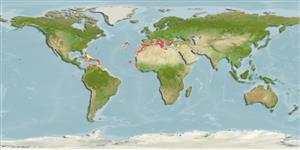Common names from other countries
Classification / Names / Names
Common names | Synonyms | Catalog of Fishes (gen., sp.) | ITIS | CoL | WoRMS
Environment: milieu / climate zone / depth range / distribution range
Ecology
Benthic; depth range 101 - 800 m (Ref. 80197). Subtropical; 45°N - 6°N, 78°W - 36°E
Atlantic Ocean and the Mediterranean Sea.
Length at first maturity / Size / Weight / Age
Maturity: Lm ? range ? - ? cm Max length : 1.6 cm CL male/unsexed; (Ref. 80197); 1.86 cm CL (female)
Maximum depth from Ref. 106425. Maximum length is based on occurrence from Ref. 80197; to be replaced with a better reference. Found on the middle and upper slopes (Ref. 79118) in mud assemblage (Ref. 102666). Non-migratory macrozooplankton feeder (Ref. 52384). Preys on euphausiids, mysids, hyperiids, insect remains, mesopelagic fish and planktonic forams (Ref. 102666).
Life cycle and mating behavior
Maturity | Reproduction | Spawning | Eggs | Fecundity | Larvae
Members of the order Decapoda are mostly gonochoric. Mating behavior: Precopulatory courtship ritual is common (through olfactory and tactile cues); usually indirect sperm transfer.
Bisby, F.A., M.A. Ruggiero, K.L. Wilson, M. Cachuela-Palacio, S.W. Kimani, Y.R. Roskov, A. Soulier-Perkins and J. van Hertum. 2005. (Ref. 19)
IUCN Red List Status (Ref. 130435)
CITES status (Ref. 108899)
Not Evaluated
Not Evaluated
Human uses
| FishSource |
Tools
Internet sources
Estimates based on models
Preferred temperature
(Ref.
115969): 13.2 - 15, mean 14.1 (based on 112 cells).
Resilience
High, minimum population doubling time less than 15 months (K=0.55-0.75).
